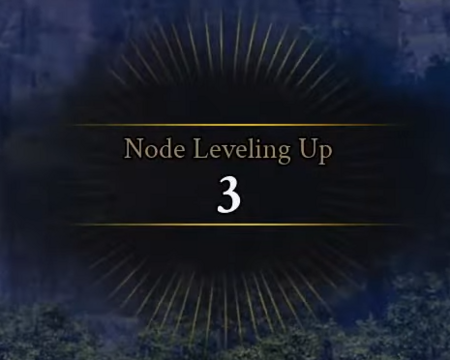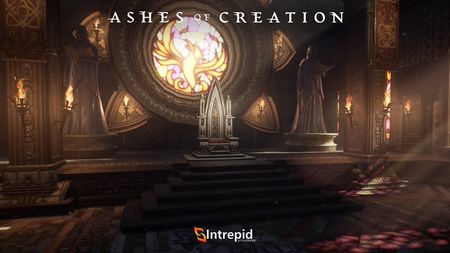Zone of influence
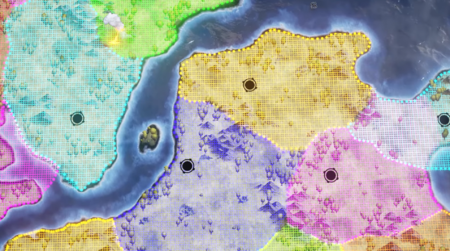
Every Node is given purview over a predefined geographic area called a Zone of Influence (ZoI). No matter where you go in the world, whether you’re questing, gathering, or raiding, you’ll be helping determine which nodes will develop, and what Zones of Influence will expand. Any area that a Node controls is considered its Zone of Influence, including Vassal Nodes, and all Vassal Nodes exist within the Zone of Influence of their Parent Node.[2] – Margaret Krohn
Every node is given purview over a predefined geographic area called a Zone of influence (ZOI). Player activity within the ZOI is weighted and counted toward a particular node’s advancement.[1]
The main thing that differentiates us from other MMOs is that we have a living, breathing, reactive world... Our world is separated into zones, which are then separated into what we call nodes. Nodes are sort of invisible zones of influence that listen to everything that a player does; so as players gain experience from killing things, gain experience from doing quests, gain experience through crafting things, the node is also gaining that experience. Once a node gains enough experience it levels up and then starts to attract NPCs to it .[3] – Jeffrey Bard
- By undertaking familiar activities, such as questing, gathering and raiding, players have agency in determining which nodes in the world will develop.[4]
Each Node can form into towns, but are limited by their neighbors. The Nodes have different levels of advancement. There can only be so many of each level. Think of this as advanced settlements needing more elbow room. Nodes encompass more land as they grow and will require more effort to be sustained. This system is a main driver for change in the world because it creates scarcity. As Nodes advance in stages of growth they will lock out neighboring Nodes from progressing, and will absorb their zones of influence.[1]
- Zones of influence connect fully across the world without any gaps.[5]
There is not a space where you will move in to do something and no node will get that experience.[5] – Steven Sharif
- Underrealm nodes and nodes directly above them are considered adjacent but do not exist in the same ZOI.[6][7][8]
- Up to one fifth of the world will be encompassed within the ZOI of a Metropolis. The many vassal nodes within a ZOI's "border" could end up looking like a country or nation.[9]
Node stages
Nodes advance by collecting experience from the actions of players nearby. As players complete content inside of a Node’s Zone of Influence (the area around the node), they contribute that experience toward the Node’s development. The experience given to the Node may then be modified based on certain Events and Accomplishments. When a Node reaches the experience required, it undergoes the process of advancing to the next stage. There are a few exceptions where a Node cannot advance even though it has the required experience - most commonly, a Node can not advance if a Node is a Vassal of another Node and would advance to the same stage as its Parent Node.[10] – Margaret Krohn
Nodes have seven (7) stages of advancement, with experience thresholds for each stage. When a Node reaches the experience required for its current stage, it advances to the next stage.[2]
| Node stage.[11] | Symbol | Alternate name.[12] | Timeframe to advance.[11] | Player housing.[13] | |
|---|---|---|---|---|---|
| 0. | Wilderness | - | |||
| 1. | Expedition | Crossroads | Few hours | - | |
| 2. | Encampment | Camp | Many hours | - | |
| 3. | Village | - | Few days | Small houses | |
| 4. | Town | - | Many days | Medium houses | |
| 5. | City | - | Few weeks | Large houses | |
| 6. | Metropolis | Metro | Many weeks | Mansions |
Node advancement
Citizen and non-citizen player activity (questing, gathering, raiding, etc.) within a node's ZOI counts toward that particular node's advancement (progression) to a higher node stage.[10][11]
The advancement of a node unlocks its unique content, which comes at the cost of locking out an increasing ring of neighboring nodes from progressing to the next stage.[15]
- Nodes advance to the first stage quickly. This enables NPC services such as vending or banking items.[16]
- The more advanced the node is, the larger its ZOI becomes.[17]
- Less advanced nodes (referred to as vassal nodes) that fall within a more advanced node's ZOI can still gain XP, but must remain at a lower advancement stage than the dominant node.[18]
- The vassal system begins when a node hits Village (stage 3), but neighboring nodes starting from Expedition (stage 1) also block the growth of their immediate neighbors.[19][20]
- Certain quests, such as story arcs, may not be able to be turned in after a node has advanced.[21]
- The territory expansion algorithm takes into account the nearest coast, neighboring nodes, and the heatmap of players in surrounding areas over the last weeks or month.[22]
- Due to the way the progression algorithm calculates territorial (ZOI) expansion during node advancement, there is a small possibility that two nodes of the same stage end up being close to each other.[23]
- The way that the algorithm expands the territories takes into account a few things: One it takes into account the coast like where's the closest coast. Two it takes into account the neighboring nodes so it can take over and essentially vassal state those nodes, but what's more important is essentially the initial population based on like how players choose their races. Because we have nine different races and four different starting points that branch out, each server's population density is going to dictate essentially the first few nodes that are highly populated and then that initial seed is what's going to determine the node structure as it moves inland into the into the world essentially; and based on the performance and successes of different sieges will determine which nodes that got locked out from the previous the initial advancements what nodes can now be available to advance further. So I really think that with so many variables that are present in the equation of how nodes advance and stay existing with the more variables you have, the higher likelihood there is for there to be a significant diversion in world progression.[22] – Steven Sharif
- Normally the algorithm that's applied to the node territorial expansion will prevent significant nodes from being in close proximity to each other... There could be a perfect storm where all of the algorithmic progression of territory leads to having these nodes very close to each other because there's certain requirements that should that need to be available to satisfy node vassal takeovers; and it's possible that two nodes would never take each other over as vassals and end up close together and spanning their territories in opposite directions: The Tale of Two Cities thing.[23] – Steven Sharif
- A node does not receive XP from the nodes within its ZOI until these nodes have reached their cap.[18]
- Node experience gain opportunities will be equitable across the four node types.[25]
- Different people have different resources invested in nodes progressing and it would be a little "gamey" if you could know exactly what was necessary at that point because that would disincentivize people from participating.[26] – Steven Sharif
Node advancement spawns a series of animations and visual effects (within the footprint of the node).[27][10]
- Players within the node are teleported to a safe location, likely a respawn area near the node.[27][28]
- Supplies will spawn around the node and system driven caravans are spawned to bring these supplies into the node. These caravans are not able to be attacked.[27]
- NPCs will begin construction activities.[27]
- Players outside the node will see the new facade of the node pop into existence as the node advances in stage.[27]
- The Development Area of a Node is where civilization will appear as the Node advances. As the Node Stage increases, different buildings, NPCs, and services will become available in the Development Area. The higher the Node Stage, the more complex and populated the Development Area becomes. Development Areas will also vary depending on the Node Type - Economic, Military, Scientific, or Divine.[10] – Margaret Krohn
Adjacent/Neighboring nodes
Adjacent nodes (Neighboring nodes) starting from Expedition (stage 1) may block (lockout) the growth of their immediate neighbors.[19][20]
- Vassal nodes must remain at least one node stage below their parent node.[2]
- Encampment (stage 2) and Expedition (stage 1) nodes are technically not vassal nodes as they do not support citizenships. If their parent Village (stage 3) node is destroyed by a node siege, these nodes are also destroyed.[29]
Vassal nodes
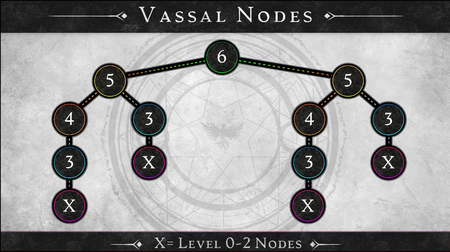
This vassal mode structure tells you what it looks like for a sovereign at a level six metropolis stage; and what it can control at a maximum vassal network is two level five nodes, of which a level five node can control one level four and one level three as direct vassals; and then the four can control a three; and every three can control a one or a two. Now if the three gets removed through siege, the one or the two is removed as well. So that's an important distinction between the three's vassals, which technically isn't really a vassal relationship because there's no citizenships possible. Those vassals don't exist between three and X, but they do exist between four and three, five and four, and six and five. And what this also allows is that because there are 85 nodes that are within the world, we have a buffer zone of about 20 nodes that lives in a max server state. So if you had maximum five metropolises form in a world, you will have a number about 20 nodes that can live alongside those metropolis networks; and when or if a metropolis falls, that extra cushion of nodes around the five metropolis structures allows for the map to be redistricted in a way that is unique. It doesn't mean that one of the fives is just going to pick up where the last six left off and form the same exact metropolis structure. From a territory perspective it has ancillary nodes to play with and expand towards that redistricts the map, so that if a metropolis falls there's a significant difference in the layout of the world and the layout of these almost nation-like territories.[29] – Steven Sharif
Village (stage 3) or higher nodes enslave nearby nodes, converting them into vassal nodes.[2][20]
- A Metropolis (stage 6) can control up to two City (stage 5) nodes. A City (stage 5) can control one Town (stage 4) and one Village (stage 3) node. A Village (stage 3) can control an Encampment (stage 2) or an Expedition (stage 1). If the Village (stage 3) gets destroyed through a siege, its dependant Encampment (stage 2) and Expedition (stage 1) nodes are also destroyed.[29]
- There is a layer of intricacy between how the neighboring nodes advance and what potential parent structure they have in the vassalship tree.[30] – Steven Sharif
- Vassal nodes gain benefits from their regent node (also referred to as sovereign node or parent node) even if the node type of the parent is different to the vassal.[31][32]
- It is not a bad thing to be vasseled, it is a good thing to be vasseled. It brings many benefits from the Sovereign, which is the ultimate parent of that vassal network down to the vassal node itself; and it allows that vassal node to even live outside of its normal mechanics. You get to adopt some of the benefits that the node type of your sovereign is, even if your node type as a vassal node isn't the same.[32] – Steven Sharif
- Regent nodes collect taxes from their vassal nodes. These taxes cannot be taken by the mayor or other players.[34]
- Vassal nodes must remain at least one node stage below their parent node.[2]
- Neighboring/Adjacent nodes from Expedition (stage 1) upward block the growth of their immediate neighbors. This was intended to be tested in Alpha-1.[19][20]
- Vassal nodes first apply any experience earned to their own deficit (see Node atrophy). It then applies excess experience earned to its parent node.[10]
- If the parent node advances, the vassal is once again able to advance.[2]
- Vassal nodes give excess experience to their parent node and may have their own vassals; so long as they fall within the parent node’s zone of influence.[34][2]
- If a node is capped and is both a vassal and has its own vassals, any experience earned from itself or its Vassals is first applied to its own deficit. Experience beyond that is then sent to its parent node.[10]
- When the vassal reaches its cap it overflows experience up to the parent; and so it can be very good early on for parents to get vassal nodes that are very productive- that have a lot of traffic.[34] – Steven Sharif
- Vassals are subject to the government, alliances, wars, taxes, and trade of their parent node, and are able to receive federal aid from them.[2]
- Vassal nodes cannot declare war on their parent node or any of their vassals.[2]
- Citizens of vassals are bound by the diplomatic states of the parent node.[2]
- If a Node is a Vassal Node and is capped from advancing further, it first applies any experience earned to its own deficit (see Node Atrophy section), and then applies excess experience earned to its Parent Node. If the Parent Node advances and the Vassal is able to grow, it becomes uncapped. If a Node is capped and is both a Vassal and has its own Vassals, any experience earned from itself or its Vassals is first applied to their own deficit. Any experience beyond that is then sent to its Parent Node.[10] – Margaret Krohn
Zones and progression
Dungeons, Raids, World bosses, Mobs, Quests, Events, Resources, Narratives and other content within a node's ZOI will have a diverse level range; but will scale with the advancement of that node and its racial influence.[35][36][2]
- Portions of the spawn tables (for mobs and resources) are static and other portions are dynamic and adapt to node development.[37]
- We don’t have a strictly level 25 zone. Instead, that zone might have some level 10 creatures near the road, some level 20 creatures deep in the forest, and some level 30 creatures up the mountain. These ratios will change based on the Nodes that inform them, becoming generally more dangerous as the Node grows. All this civilization attracts the attention of Things-That-Should-Not-Be. This does not mean that wilderness areas are safe, by any means. Some may be safe-er, but all will have dangers that even the most experienced traveler needs to watch out for.[38] – Steven Sharif
World manager
The World manager is an algorithm in Ashes of Creation that controls dynamic world elements. It acts as both a throttle and an incentive system for various activities to ensure certain parameters are within acceptable thresholds.[39]
- A world manager is a technical term to define a server process that lives alongside the game server; and when the game server needs to do things- communicating with other game servers within that grid- it tells that manager and that manager sends it down to the appropriate server.[40] – Steven Sharif
- Prices of glint.[41]
- A heatmap of experience being gained to apply to node advancement.[41]
- The territory expansion algorithm takes into account the nearest coast, neighboring nodes, and the heatmap of players in surrounding areas over the last weeks or month.[22]
- Due to the way the progression algorithm calculates territorial (ZOI) expansion during node advancement, there is a small possibility that two nodes of the same stage end up being close to each other.[23]
- Transit of resources and goods between regions to drive quest rewards for nodes.[41]
- For example if you know iron is being used as a raw resource for a specific crafting path that might drive up the price of mithril or silver; and that will incentivize the market to course correct a little bit. The idea is to provide soft incentives that help to alleviate the demand and also to prop up the supply that might not be present from the economic systems.[41] – Steven Sharif
Underrealm nodes
Underrealm nodes and nodes directly above them are considered adjacent but do not exist in the same ZOI.[6][7][8]
- There will be "bleed over" between underrealm nodes and surface nodes in terms of influence and interaction.[7]
- There may be visual cues above ground that indicate influence from underrealm nodes in that area.[7]
That might be a little bit of a departure from our design in the past. I know originally like two-plus years ago we were discussing how those would be independent of each other, but I think as we further defined the layout of the world map itself it made more sense for those to have some interaction and influence that's combined.[7] – Steven Sharif
- Caravan routes will go underground.[42]
- Node sieges occur in the usual manner.[43]
- There will be underrealm Metropolises.[44]
Castle regions
Guild castles influence a castle region around them.[45]
- A castle's region is 1/5th the game world.[46]
- Castle regions, Economic regions, and Node ZOI (Zones of Influence) can overlap.[47][48]
- A castle could have a metropolis beside it.[49]
- Castle region boundaries are static.[47]
- Guild castles impose a tax on all revenue for the nodes within its region.[50][51]
Node simulation
This representation does show 111 nodes as part of this particular simulation. I'm not sure what the tick frequency is on this video. It might be something on the magnitude of like every second is probably 12 to 24 hours. So over time you start seeing these larger node systems building up to eventually where you might see Cities and Metropolises after some period of time; and what this allows the design team to do from a tools perspective, as they simulate this idea of how the world is going to progress, is it gives an opportunity to see strange happenings or something that we couldn't necessarily predict but was a possible outcome based on the variables present.[52] – Steven Sharif
The developers have created a simulation of node interactions in preparation for Alpha-2 deployment of the node system.[52]
- This simulates how nodes advance and expand their zones of influence over surrounding nodes.[52]
You can show the initial territories on the Verran map of what these particular nodes have governance over, or their Zones of Influence as we like to call them... As the simulation of this begins to advance and nodes begin to expand their territory and they begin to take over nearby nodes as a result of their of their growth, you start to see these power level ratings that are applied here on specific nodes that determines what type of takeover power it has and and what it pushes back against for other nodes that are looking to take over new territory as they advance.[52] – Steven Sharif
- It also simulates events, such as NPCs attacking and disabling certain node buildings and services. Failure to successfully respond to these will reduce the node's "health ticker", which will slow down the XP gains from the node.[52]
It also simulates events: So each of these nodes will have a health ticker: when that health ticker is impacted it'll stop gaining power or gaining or slow down in its gaining of experience; and that's because certain events can affect a node by disabling certain services, disabling buildings. Players don't respond to that horde of zombies that have come out of the nearby ravine then those zombies can attack stables, they can attack service buildings, and prevent particular types of quests or activities and services from happening until it's repaired.[52] – Steven Sharif
- Node sieges are simulated, with successful sieges destroying the nodes, and where unsuccessful sieges won't destroy the node but may result in disabled buildings or services, similar to events.[52]
It simulates the sieges if a particular node has a certain frequency that's set where we want to see randomization of how nodes get affected by sieges. Sometimes they'll be destroyed in the simulation. Sometimes they'll have disabled services again, similar to an event, because they didn't succeed necessarily at sieging the node but they did succeed at disabling some of the buildings as part of that siege.[52] – Steven Sharif
- It simulates what outcomes may happen in the live game as a result of player activity, such as splitting up a particular ZOI across a waterway, or having territories expand out to islands or across continents.[52]
It simulates what players could potentially do as well when the game goes live; and that might include things like splitting up a particular Zone of Influence across a waterway, having your territory expand out to an island, or across continents. These are these are the types of things that we want to see players do eventually obviously but this tool provides the design team the opportunity to see it repetitively and over a fast period of time so they see these different types of outcomes.[52] – Steven Sharif
World size
1,200 km2 (square kilometers) is the expected total world size of Verra at launch, including land (480 km2) and water/ocean (750 km2), but excluding the size of the Underrealm.[53]
- This has increased from the previously stated total size of 480 km2 including land and water/ocean[54][55][56]; but excluding an additional ~100 km2 of Underrealm.[57]
- The Underrealm did not increase "too much" in size.[58]
- The reason given for expanding the map size was to better accommodate Naval content and to reduce the overall content density in the world.[53]
- The purpose of it becoming bigger is as I said to make sure that density isn't overwhelming: that it isn't everywhere I look there is immediately something. I have no opportunity to see areas of the world that are expansive and are just wanderlust adventure feeling. Everything was sitting on top of you, POIs and nodes and houses and everything. It was like an urban area everywhere. But we wanted to expand that because a large portion of the game is a sandbox element; it's coupled with a lot of curated content but it's that sandbox element.[53] – Steven Sharif
- The shape of the continents has also changed and two new large islands have been introduced.[53]
See also
References
- ↑ 1.0 1.1 1.2 Node series part I
- ↑ 2.00 2.01 2.02 2.03 2.04 2.05 2.06 2.07 2.08 2.09 2.10 Blog - Know Your Nodes - The Basics.
- ↑ Interview, April 20, 2018 (7:22).
- ↑ Ashes of Creation FAQ.
- ↑ 5.0 5.1 Livestream, July 9, 2018 (39:32).
- ↑ 6.0 6.1 Livestream, March 29, 2019 (58:14).
- ↑ 7.0 7.1 7.2 7.3 7.4 Livestream, March 29, 2019 (29:17).
- ↑ 8.0 8.1 Livestream, May 5, 2017 (37:52).
- ↑ Interview, May 11, 2018 (55:16).
- ↑ 10.0 10.1 10.2 10.3 10.4 10.5 10.6 Blog - Know Your Nodes - Advance and Destroy.
- ↑ 11.0 11.1 11.2 A reactive world - Nodes.
- ↑ Livestream, December 12, 2018 (14:48).
- ↑ Interview, July 20, 2020 (3:45).
- ↑ Video, February 29, 2024 (33:57).
- ↑ Video, April 20, 2017 (0:02).
- ↑
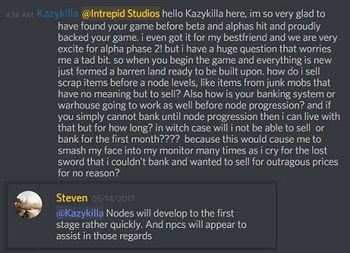
- ↑ Node series part II – the Metropolis.
- ↑ 18.0 18.1 Livestream, October 16, 2017 (50:20).
- ↑ 19.0 19.1 19.2

- ↑ 20.0 20.1 20.2 20.3

- ↑ Livestream, February 29, 2024 (53:58).
- ↑ 22.0 22.1 22.2 Interview, July 18, 2020 (10:04).
- ↑ 23.0 23.1 23.2 Interview, July 8, 2020 (1:00:15).
- ↑
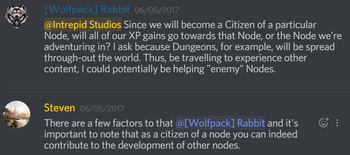
- ↑ Livestream, September 24, 2021 (1:21:23).
- ↑ 26.0 26.1 Livestream, May 26, 2017 (28:16).
- ↑ 27.0 27.1 27.2 27.3 27.4 Livestream, October 14, 2022 (55:13).
- ↑ Livestream, November 17, 2017 (55:27).
- ↑ 29.0 29.1 29.2 29.3 Livestream, August 26, 2022 (1:07:34).
- ↑

- ↑ Livestream, August 31, 2023 (52:56).
- ↑ 32.0 32.1 Livestream, August 26, 2022 (1:04:35).
- ↑

- ↑ 34.0 34.1 34.2 Livestream, August 26, 2022 (1:10:16).
- ↑ Interview, July 19, 2020 (19:35).
- ↑ Livestream, May 15, 2017 (30:53).
- ↑ Livestream, August 26, 2022 (1:28:50).
- ↑ Interview: Ashes of Creation on Building Their Virtual World, 2017-04-13.
- ↑ Interview, July 19, 2020 (1:10:55).
- ↑ Livestream, October 14, 2022 (57:22).
- ↑ 41.0 41.1 41.2 41.3 Interview, July 19, 2020 (1:08:22).
- ↑ Livestream, May 26, 2017 (31:44).
- ↑ Livestream, May 26, 2017 (42:45).
- ↑ Livestream, May 24, 2017 (31:39).
- ↑

- ↑

- ↑ 47.0 47.1

- ↑

- ↑

- ↑ Livestream, April 30, 2021 (1:01:10).
- ↑

- ↑ 52.00 52.01 52.02 52.03 52.04 52.05 52.06 52.07 52.08 52.09 52.10 Livestream, September 24, 2021 (30:26).
- ↑ 53.0 53.1 53.2 53.3 Livestream, August 26, 2022 (46:52).
- ↑ Livestream, January 30, 2020 (1:18:12).
- ↑

- ↑

- ↑ Interview, August 17, 2018 (10:43).
- ↑ Livestream, April 7, 2023 (22:48).
